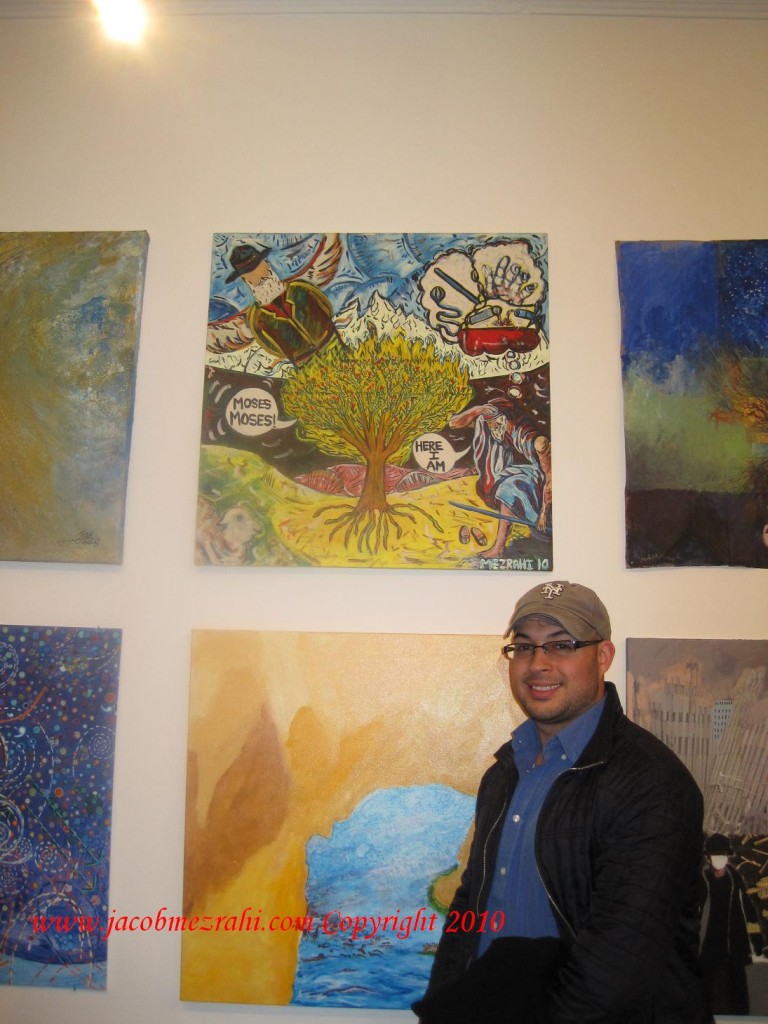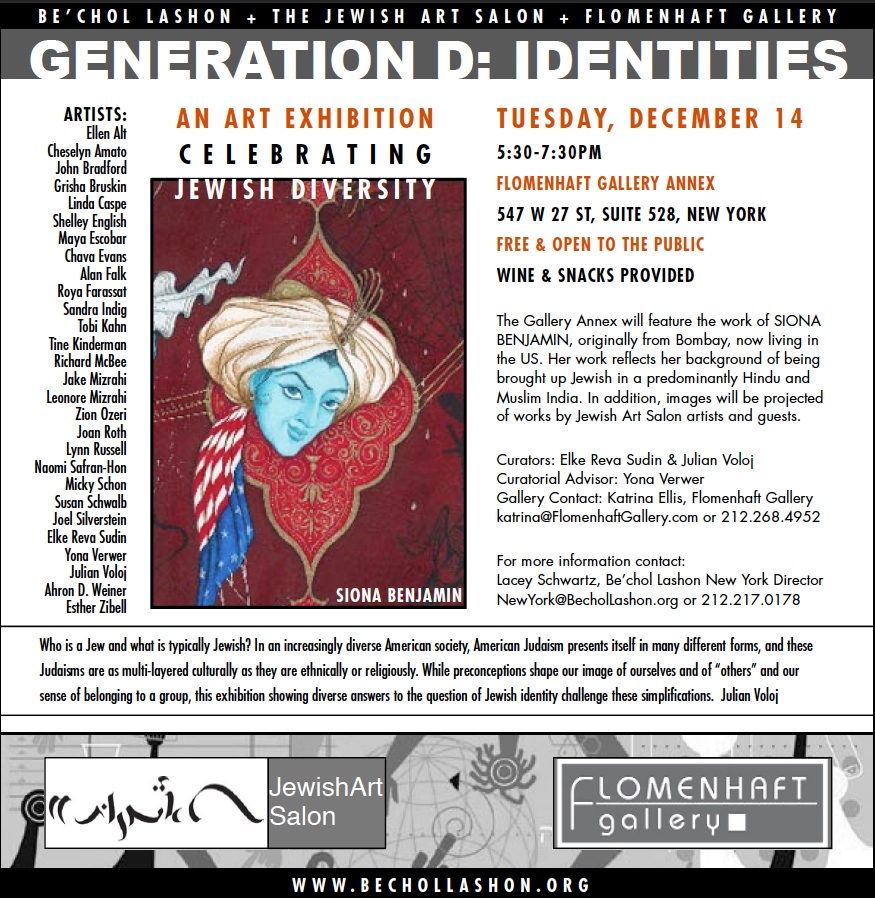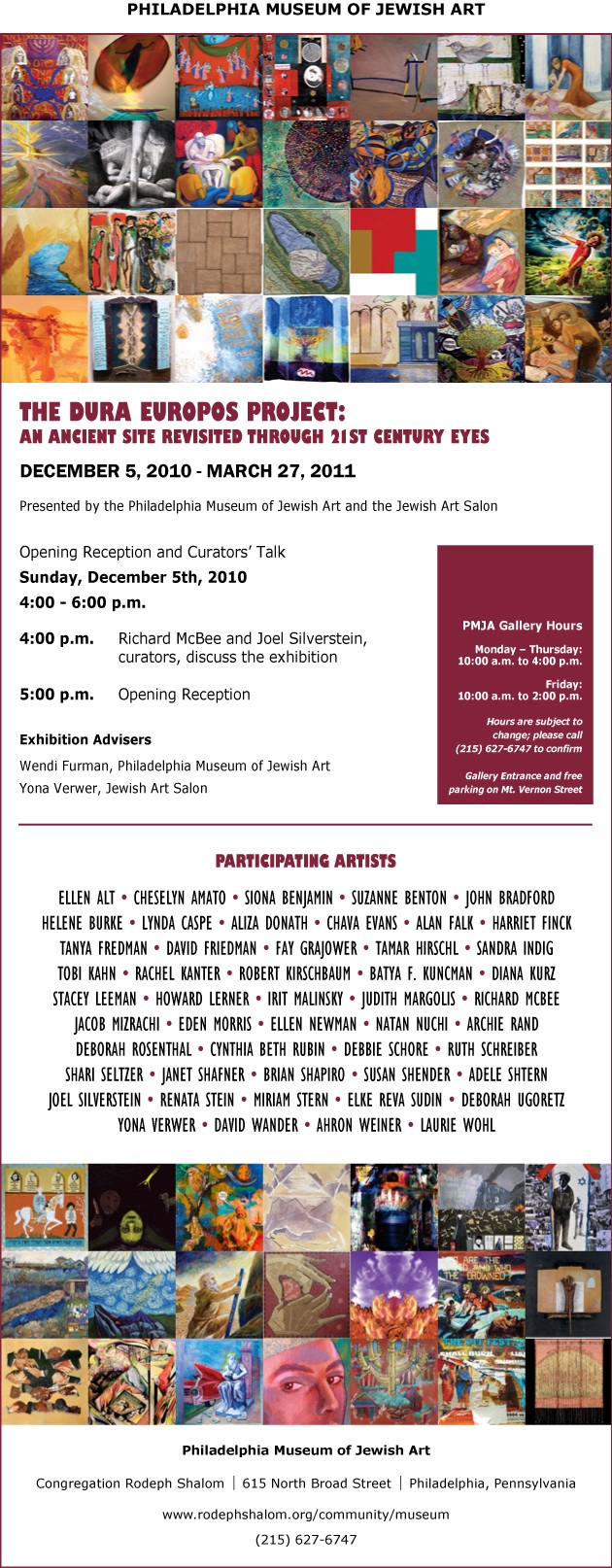Artist.
My Exhibits Info
The Jewish Daily Forward, January 18, 2011, By Aubrey Whelan
Jan 20th
January 18, 2011, 12:52pm
Images of Ben-Gurion and Ahmadinejad Update Ancient Frescoes
By Aubrey Whelan
King David is a smiling child in a red T-shirt and corduroys. Mahmoud Ahmadinejad fills in for Haman. David Ben-Gurion is leading Holocaust survivors across the Red Sea.
That’s the aim of the Dura Europos Project, on view at the Philadelphia Museum of Jewish Art until March 27 — to present a decidedly modern take on the oldest known examples of Jewish artwork.
Discovered in 1920 in a synagogue in the ancient Roman town of Dura, the Dura Europos frescoes date to 245 C.E. and depict scenes from the Tanach — everything from the story of Esther to Ezekiel’s vision of dry bones.
The project, curated by Joel Silverstein and Richard McBee, features paintings created specifically for the exhibit by members of New York’s Jewish Art Salon, based on portions of the frescoes.
“It’s a show where there’s something for everyone — the works are so rich, varied and diverse,” said Wendy Furman, the museum’s executive director. About 200 people showed up for the exhibit’s opening in December; it features the largest number of artists the museum has ever exhibited at one time, Furman said.
The 101 pieces exhibited run the gamut from more traditional depictions of Torah scenes to hypermodern interpretations of the stories.
Natan Nuchi’s “The Binding of Isaac” was created entirely in Adobe Photoshop. Robert Kirschbaum’s “Number 1, from Ashlar Series,” is simply three interlocking shapes in acrylic on wood, meant to represent the designs on Solomon’s temple.
Some, like Ellen Deitell Newman’s “Purim Re-Visited,” make no bones about their politically-charged themes. Newman’s piece, in acrylic on linen, depicts Mahmoud Ahmadinejad as Haman leading Elie Wiesel as Mordechai astride a horse. Some are clear homages to fellow artists — the comic-book style of Jacob Mezrahi’s “Moses Moses” recalls elements of Roy Lichenstein.
In their introduction to the exhibit, curators Silverstein and McBee write that the exhibit aims to explore what it means to be a Jewish artist in the modern world.
“This particular group of Jews,” they write, “struggles to resolve their religious origins within their status as contemporary artists in America.”
Furman said a fair number of people have passed through the exhibit, which has drawn members of Congregation Rodeph Shalom — where the museum is housed — as well as outside visitors.
“It has a broad reach, and there’s good scholarship behind the pieces,” she said. “Each piece is really unique.”
ARTICLE IN VALLEY STREAM HERALD, By Clarissa Hamlin
Jan 12th
http://www.liherald.com/detail.html?sub_id=29904
VALLEY STREAM HERALD
|
Anyone looking at the art of resident Jacob Mezrahi will be bombarded with not only an image, but a striking message that might just touch their soul.
Specializing in the area of narratives, his art tells a story — one which he hopes will inspire a reaction from the part of his viewers. “Art is meant to be viewed,” he said. “The whole point is for people to see it and walk away feeling different having saw it. I hope people see my work and respond.”
One of Mezrahi’s paintings is featured in an exhibit, “Dura Eurpos,” at the Philadelphia Museum of Jewish Art which runs through March 27. His piece, “Moses and the Burning Bush,” is a creative image illuminated by a powerful moral, he said. “I added a story to my own idea of the image,” he said. “I put in a dialogue between God and Moses in the form of a comic into the piece.”
Mezrahi noted that the narrative part of the painting is the message that God is showing Moses that at that time, he could have the strength to step up and be a leader. The 30-inch by 30 size piece was the result of looking at a dozen different images in art books. “Mostly I created the painting and put in colors,” he said. “Most of the painting was my own imagination, but based on changing many different images I saw in art books.” The piece is a part of a collection of biblical-themed artwork on display there. Organized by the Jewish Art Salon that Mezrahi is a member and in collaboration with the museum, the event creators were inspired by biblical artwork uncovered in a synagogue around the 1920s in Syria — the synagogue had been around since 17,000 years ago, Mezrahi said.
“The exhibit creators wanted to re-create murals on the synagogue walls uncovered through modern day eyes,” he said, “so they asked like 30 different artists to contribute one piece and do a modern day image.”
For 30-year-old Mezrahi, art is more than just a way to express himself, it is a way to make a statement. Starting in high school, he has been making artistic statements for 15 years and does not plan on stopping anytime soon. “Art is a way of expressing my ideas, a hobby and chance to get to relax and have stress relief, and an enjoyable outlet that tells what I feel and what I am,” he said.
Following a narrative format, Mezrahi defines each of his paintings with a message ranging anywhere from political to social. Whether a painting is an expression of happiness, sadness, or just meant to make a viewer remember something, the image may be a simple photo that has been altered in an artistic way or a completely new sketch. His paintings come from the heart and are inspired by everyday life, he said.
“I see something that inspires me and if I have time, I go into my studio area and try to start a piece,” he said. “I put my inspiration on canvas.” A painting titled “The Night of Broken Glass” is a special one, he said, that focuses on a message of remembrance pertaining to the Holocaust. Starting with a black and white photo of a synagogue burning during the historic period, Mezrahi replaced the smoke in the picture with writing indicating the Nov. 10, 1938, date of the event.
He noted that the time spent working on a piece depends on whether he has much free time aside from working as a full-time teacher at Murrow High School in Brooklyn. Though he tries to get a lot done in one day, that does not always work out. A piece might be done in a couple of days, or it might take years.
But no matter how much time a painting may take, he said that his family is very supportive. “My parents, wife, friends and everyone I work with support me by going to the exhibits,” he said, “or if in the middle of a painting, I leave it out and people come by and tell me what they think.”







Recent Comments